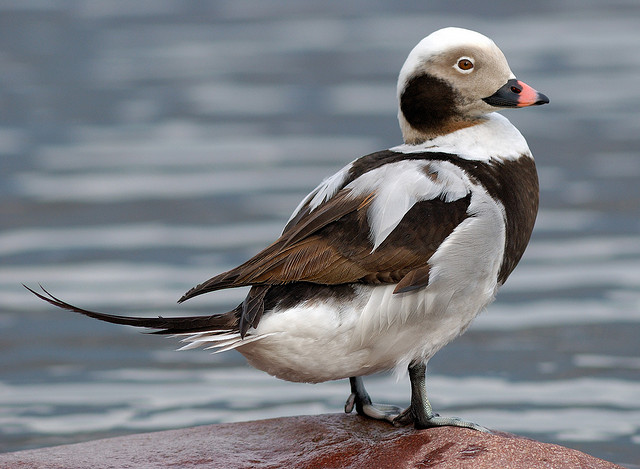
Long-tailed duck, orOldsquaw(Clangula hyemalis)
Phylum —chordata
Class — aves
Order — anseriformes
Family — anatidae
Genus –clangula
Appearance
Adults have white underparts, though the rest of the plumage goes through a complex moulting process. The male has a long pointed tail (10 to 15 cm (3.9 to 5.9 in) long) and a dark grey bill crossed by a pink band. In winter, the male has a dark cheek patch on a mainly white head and neck, a dark breast and mostly white body. In summer, the male is dark on the head, neck and back with a white cheek patch. The female has a brown back and a relatively short pointed tail. In winter, the female's head and neck are white with a dark crown. In summer, the head is dark. Juveniles resemble adult females in autumn plumage, though with a lighter, less distinct cheek patch.
Measurements: length – 440-600 mm (17,5-23,5 in), weight – 740 g (1, 63 lb), wingspan – 710 mm (28 in).
Habitat
Their breeding habitat is in tundra pools and marshes, but also along sea coasts and in large mountain lakes in the North Atlantic region, Alaska, northern Canada, northern Europe, and Russia. They are migratory and winter along the eastern and western coasts of North America, on the Great Lakes, coastal northern Europe and Asia, with stragglers to the Black Sea. The most important wintering area is the Baltic Sea, where a total of about 4.5 million gather.
Behavior
The long-tailed duck is gregarious, forming large flocks in winter and during migration. Mostly seen on the water where it is a strong swimmer and an active diver. Flight is erratic and wingbeats are unusual, with deep downbeats and shallow upbeats.
Diet
Long-tailed ducks are excellent divers, with their favorite foods being crustaceans and mollusks.
Reproduction
The long-tailed duck has a circumpolar polar distribution. In North America it breeds along the Arctic Coast from Alaska to Greenland and throughout the Canadian tundra. Long-tailed ducks often nest in clusters on nearby offshore islands and coastal tundras. Long-tailed hens lay an average of 7 eggs.
In captivity
The long-tailed duck's average lifespan is 15.3 years.
A house for ducklings are built at a distance of at least 100 mfrom the water. The length of the coastal strip near the duck house for 500 heads is set at least 100 m. The slope of the bank should not exceed 30°. One adult duck is allocated 25-30 m2 of water surface.
Where there is a reservoir near the farmstead, ducks are allowed to swim in winter. For this purpose, an ice hole is made by keepers. To prevent ducks from diving under the ice, the hole to a depth of 1 m is fenced with a net, and a layer of straw is laid at the hole in 3-5 cm. Low water temperature is not a barrier for ducks - a warm fat layer reliably protects the body from hypothermia.
Keeping ducks in marine reservoirs with a salinity of more than 10 g of salt per liter of water it is necessary to install drinkers for the birds on the shore. Marine reservoirs also contain a significant number of aquatic plants and small animals (crustaceans, mollusks) suitable for feeding ducks.
 Russian
Russian
 English
English
























